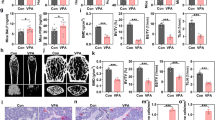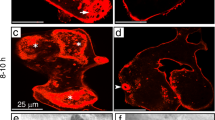Abstract
Metabolic skeletal disorders associated with impaired bone formation are a major clinical challenge. One approach to treat these defects is to silence bone-formation–inhibitory genes by small interference RNAs (siRNAs) in osteogenic-lineage cells that occupy the niche surrounding the bone-formation surfaces. We developed a targeting system involving dioleoyl trimethylammonium propane (DOTAP)-based cationic liposomes attached to six repetitive sequences of aspartate, serine, serine ((AspSerSer)6) for delivering siRNAs specifically to bone-formation surfaces. Using this system, we encapsulated an osteogenic siRNA that targets casein kinase-2 interacting protein-1 (encoded by Plekho1, also known as Plekho1). In vivo systemic delivery of Plekho1 siRNA in rats using our system resulted in the selective enrichment of the siRNAs in osteogenic cells and the subsequent depletion of Plekho1. A bioimaging analysis further showed that this approach markedly promoted bone formation, enhanced the bone micro-architecture and increased the bone mass in both healthy and osteoporotic rats. These results indicate (AspSerSer)6-liposome as a promising targeted delivery system for RNA interference–based bone anabolic therapy.
This is a preview of subscription content, access via your institution
Access options
Subscribe to this journal
Receive 12 print issues and online access
$209.00 per year
only $17.42 per issue
Buy this article
- Purchase on Springer Link
- Instant access to full article PDF
Prices may be subject to local taxes which are calculated during checkout





Similar content being viewed by others
References
Black, D.M. et al. The effects of parathyroid hormone and alendronate alone or in combination in postmenopausal osteoporosis. N. Engl. J. Med. 349, 1207–1215 (2003).
Hodsman, A.B. et al. Parathyroid hormone and teriparatide for the treatment of osteoporosis: a review of the evidence and suggested guidelines for its use. Endocr. Rev. 26, 688–703 (2005).
Cosman, F. et al. Daily and cyclic parathyroid hormone in women receiving alendronate. N. Engl. J. Med. 353, 566–575 (2005).
Lindsay, R. et al. Randomised controlled study of effect of parathyroid hormone on vertebral-bone mass and fracture incidence among postmenopausal women on oestrogen with osteoporosis. Lancet 350, 550–555 (1997).
Neer, R.M. et al. Effect of parathyroid hormone (1–34) on fractures and bone mineral density in postmenopausal women with osteoporosis. N. Engl. J. Med. 344, 1434–1441 (2001).
López-Fraga, M., Martinez, T. & Jimenez, A. RNA interference technologies and therapeutics: from basic research to products. BioDrugs 23, 305–332 (2009).
Novina, C.D. & Sharp, P.A. The RNAi revolution. Nature 430, 161–164 (2004).
Itaka, K. et al. Bone regeneration by regulated in vivo gene transfer using biocompatible polyplex nanomicelles. Mol. Ther. 15, 1655–1662 (2007).
Wang, D., Miller, S.C., Kopeckova, P. & Kopecek, J. Bone-targeting macromolecular therapeutics. Adv. Drug Deliv. Rev. 57, 1049–1076 (2005).
Wang, D. et al. Osteotropic peptide that differentiates functional domains of the skeleton. Bioconjug. Chem. 18, 1375–1378 (2007).
Yarbrough, D.K. et al. Specific binding and mineralization of calcified surfaces by small peptides. Calcif. Tissue Int. 86, 58–66 (2010).
Lu, K. et al. Targeting WW domains linker of HECT-type ubiquitin ligase Smurf1 for activation by Ckip-1. Nat. Cell Biol. 10, 994–1002 (2008).
Zhang, L. et al. The PH domain containing protein Ckip-1 binds to IFP35 and Nmi and is involved in cytokine signaling. Cell. Signal. 19, 932–944 (2007).
Stuart, A.J. & Smith, D.A. Use of the fluorochromes xylenol orange, calcein green, and tetracycline to document bone deposition and remodeling in healing fractures in chickens. Avian Dis. 36, 447–449 (1992).
Aubin, J. & JNM., H. Bone cell biology: osteoblast, osteocyte and osteoclasts. in Pediatric Bone 43–47 (Academic Press, San Diego, California, USA, 2002).
Gronthos, S. et al. Differential cell surface expression of the STRO-1 and alkaline phosphatase antigens on discrete developmental stages in primary cultures of human bone cells. J. Bone Miner. Res. 14, 47–56 (1999).
Ishikawa, S. et al. Involvement of FcRγ in signal transduction of osteoclast-associated receptor (OSCAR). Int. Immunol. 16, 1019–1025 (2004).
Kim, N., Takami, M., Rho, J., Josien, R. & Choi, Y. A novel member of the leukocyte receptor complex regulates osteoclast differentiation. J. Exp. Med. 195, 201–209 (2002).
Posner, A.S. & Betts, F. Synthetic amorphous calcium-phosphate and its relation to bone-mineral structure. Acc. Chem. Res. 8, 273–281 (1975).
Hoang, Q.Q., Sicheri, F., Howard, A.J. & Yang, D.S. Bone recognition mechanism of porcine osteocalcin from crystal structure. Nature 425, 977–980 (2003).
Midura, R.J. et al. Bone acidic glycoprotein-75 delineates the extracellular sites of future bone sialoprotein accumulation and apatite nucleation in osteoblastic cultures. J. Biol. Chem. 279, 25464–25473 (2004).
Steitz, S.A. et al. Osteopontin inhibits mineral deposition and promotes regression of ectopic calcification. Am. J. Pathol. 161, 2035–2046 (2002).
Takahashi-Nishioka, T. et al. Targeted drug delivery to bone: pharmacokinetic and pharmacological properties of acidic oligopeptide-tagged drugs. Curr. Drug Discov. Technol. 5, 39–48 (2008).
Wang, D., Miller, S., Sima, M., Kopeckova, P. & Kopecek, J. Synthesis and evaluation of water-soluble polymeric bone-targeted drug delivery systems. Bioconjug. Chem. 14, 853–859 (2003).
Federman, N. & Denny, C.T. Targeting liposomes toward novel pediatric anticancer therapeutics. Pediatr. Res. 67, 514–519 (2010).
Wang, G., Kucharski, C., Lin, X. & Uludag, H. Bisphosphonate-coated BSA nanoparticles lack bone targeting after systemic administration. J. Drug Target. 18, 611–626 (2010).
Cullis, P.R., Mayer, L.D., Bally, M.B., Madden, T.D. & Hope, M.J. Generating and loading of liposomal systems for drug-delivery applications. Adv. Drug Deliv. Rev. 3, 267–282 (1989).
Vegni, F.E., Corradini, C. & Privitera, G. Effects of parathyroid hormone and alendronate alone or in combination in osteoporosis. N. Engl. J. Med. 350, 189–192, author reply 189–192 (2004).
Acknowledgements
We thank X.-H. Yang for technical support with the confocal imaging, H. Yang for technical support with the flow cytometry and F.C. Chun-Wan for assistance with the bone histomorphometry. This study was supported by the Chinese National Basic Research Programs (2011CB910602), the Hong Kong Competitive Earmarked Research Grant (CUHK479111 and 473011), the Direct Grant of Faculty of Medicine of the Chinese University of Hong Kong (2041478 and 2041525), the Faculty Research Grant of Hong Kong Baptist University (30-08-089), the Chinese National Natural Science Foundation Project (30830029) and the National Key Technologies Research and Development Program for New Drugs (2009ZX09503-002).
Author information
Authors and Affiliations
Contributions
All the authors were involved in conducting, drafting or revising the manuscript. All the authors approved the final version of the manuscript for submission. L.Q. had full access to all of the data in the study and takes responsibility for the integrity of the data and the accuracy of the data analysis. Study conception and supervision: G.Z., L.Q., L. Zhang, F.H. Design and preparation of delivery system: G.Z., H.W., Z.Y., H.C., Y.L., K.T. Design, synthesis and screening of siRNA sequences: T.T., G.Z., L. Zheng, Z.H., N.D. Analysis and interpretation of data from cell biology and molecular biology: B.G., T.T., B.-T.Z., G.Z., D.L., X.W., L.Q. Analysis and interpretation of data from immunohistochemistry: B.-T.Z., B.G., G.Z., K. Lee, L.Q. Analysis and interpretation of data from biophotonic imaging: B.G., G.Z., G.L., L.Q. Analysis and interpretation of data from microCT and bone histomorphometry: B.G., G.Z., Y.H., Y.W., L.Q. Analysis and interpretation of data for clinical relevance: G.Z., L.Q., X.P., L.H., K. Leung.
Corresponding authors
Ethics declarations
Competing interests
The authors declare no competing financial interests.
Supplementary information
Supplementary Text and Figures
Supplementary Figures 1–4, Supplementary Tables 1–4, Supplementary Methods, Supplementary Discussion and Supplementary Results (PDF 3361 kb)
Rights and permissions
About this article
Cite this article
Zhang, G., Guo, B., Wu, H. et al. A delivery system targeting bone formation surfaces to facilitate RNAi-based anabolic therapy. Nat Med 18, 307–314 (2012). https://doi.org/10.1038/nm.2617
Received:
Accepted:
Published:
Issue Date:
DOI: https://doi.org/10.1038/nm.2617
This article is cited by
-
Liposomal α-cyperone targeting bone resorption surfaces suppresses osteoclast differentiation and osteoporosis progression via the PI3K/Akt axis
Nano Research (2024)
-
Peptide-modified PAMAM-based bone-targeting RNA delivery system
Future Journal of Pharmaceutical Sciences (2023)
-
Targeting strategies for bone diseases: signaling pathways and clinical studies
Signal Transduction and Targeted Therapy (2023)
-
Nanoparticle-mediated selective Sfrp-1 silencing enhances bone density in osteoporotic mice
Journal of Nanobiotechnology (2022)
-
Bone marrow-targetable Green Tea Catechin-Based Micellar Nanocomplex for synergistic therapy of Acute myeloid leukemia
Journal of Nanobiotechnology (2022)



